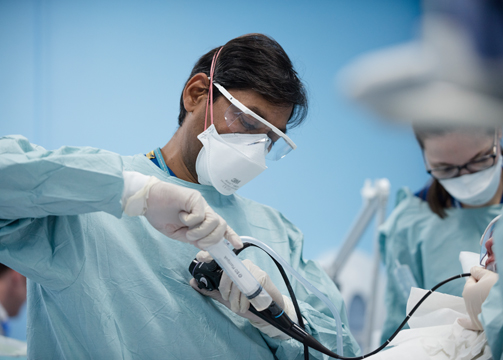
Shah performs a procedure in Royal Brompton's
bronchoscopy suite
Asthma sufferers are being given new hope for improved treatment with a new procedure at Royal Brompton Hospital.
The trailblazing therapy, called targeted lung denervation (TLD), was highlighted by an article in the Daily Mail this week.
TLD has already shown excellent results for the treatment of chronic obstructive pulmonary disease (COPD). The Daily Mail and Mail Online interviewed Professor Pallav Shah, consultant respiratory physician,
and Kim Burgess, who suffers from COPD.
Although not a cure, preliminary results show TLD can provide significant improvement in symptoms for many patients.
Now, the RELIEF-1 trial is investigating whether those with
asthma can benefit too.
Professor Shah said: “In the worldwide studies of TLD for COPD, about 70 percent of patients who have undergone the procedure have seen an improvement in lung capacity, breathlessness and quality of life.
“We’re now looking at whether this treatment can also help those with severe asthma. Both of these lung conditions are triggered in the same way.”
Targeted lung denervation works by using heat energy in the form of radiofrequency waves, to destroy branches of the vagus nerve that are no longer working properly.
This prevents the faulty nerve branches from sending messages which cause muscles to tighten and produce mucus.
Professor Shah continued: “We are aware the tiny branches of the vagus nerve – which stretches from the brain, down the windpipe and into the lungs and are wrapped around the outside of the lungs’ airways – worsen the effects of the condition.
“This is because the nerves cause the muscles that line the airway to become overactive, rather than moving smoothly as they do in those without the disease.
This, combined with the excessive production of mucus that coats the airways from the effects of chronic smoking, makes them narrower and more irritated.
“This constriction means the air cannot flow in and out so easily, so those with COPD are left short of breath and often suffering from a persistent cough, wheezing and a tight chest.”
Professor Shah said: “The results with COPD are very promising. There was no improvement in the placebo group but dramatic improvements in ten patients treated with the real treatments. We will have a clearer picture when the data has been further analysed in the next three months.”
The team at Royal Brompton now hopes to see similar results when TLD is used with asthma patients.
The patient’s view
Kim Burgess, 57, a former policeman and one of the patients on the COPD trial said the treatment had made a significant improvement to his health.
Speaking to the Daily Mail, Kim said: “Before I had the procedure, my consultant said my lungs were only 33 percent as effective as they should be at my age, which was a shock to hear. They said I would remain on the meds for the time being. I wanted to avoid having to use an oxygen tank as long as I could.”
Kim felt there was an instant improvement after having the procedure: “My chest did not feel so congested. I could push myself that little bit further when walking without feeling so breathless. My cough, that had been constant since I was diagnosed five years ago, stopped straight away.
“At a regular check-up in November, my consultant said my lung function had improved by 10 percent, which is massive for lungs as poor as mine. It’s not a cure – I still have to take medication, but I can now walk with much less difficulty than before having the procedure.”
Read the Daily Mail article on their website.
